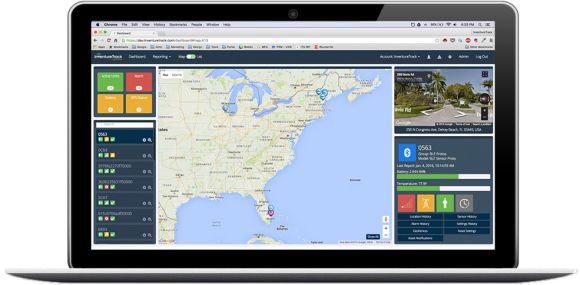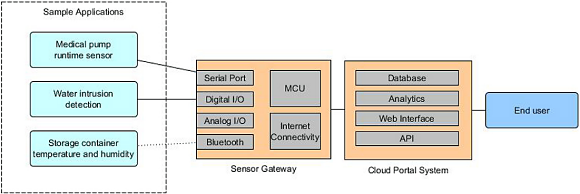
The Internet of Things (IoT) and Big Data revolution is playing out today as more and more "dumb" devices are made "smart" by adding sensors and an Internet connection to sophisticated cloud-based database systems that generate analytics from this previously untapped data collection. Sensor design companies play a pivotal role in this process, providing devices that interface the physical world to this virtual universe, feeding it with data.
However, sensor companies face a challenge monetizing their contribution to this market. Teams creating data systems that collect, store and analyze IoT data sell high-margin software products that produce subscription annuities, providing profits and operational funding for the whole life of devices deployed in the world (Figure 1).

Fig. 1: Data systems collect, store, and analyze IoT data.
Likewise firms providing Internet connectivity build revenue streams by adding ubiquitous IoT devices to their subscription base. Companies engaged in designing and manufacturing sensors sell typically low-margin hardware devices that produce a one-time revenue for each device sold. The greatest part of the value of the IoT is the data and associated analytics, but sensor companies are not in a strong position to claim revenue from ongoing data collected by their devices.
Of course many sensors are used in final products or deployed by themselves with no IoT capability. Providing IoT capability may add utility for the end user but upgrading designs with internet connectivity and building or integrating with a cloud portal requires time and expense and may involve skills outside the core competencies of the existing engineering teams. In these cases a potential revenue stream is being left on the table, so naturally solutions are becoming available to recapture it.
Next page
For sensor companies, one of the most promising of these solutions is the paired telemetry gateway and cloud portal (Figure 2). Telemetry gateways provide internet connectivity and typically a set of built-in sensors such as GPS, accelerometer or temperature, and have a host of flexible I/O ports to interface with external sensors. The sensor-gateway interface could be wired, with gateway providing power to the sensor and communicating with the sensor with a serial protocol or basic digital or analog I/Os, or the interface could be wireless, utilizing a low-power wireless technology such as Bluetooth Low Energy (BLE).

Fig. 2: A diagram of a paired telemetry gateway and cloud portal.
A paired gateway and cloud portal solution further simplifies integration efforts, as the gateway and portal are already designed to work efficiently and securely together. With this, the total design work needed to bring a sensor product to the IoT is to establish the interface between the sensor and the gateway and, if needed, customize the cloud portal as appropriate for the end users of the sensor. Because the paired solution was designed to flexible, this process is typically very quick and involves little or no NRE expenditure.
Some examples could include fill level sensors to trigger crucial refill of product at a remote site, hazardous gas detection for lone workers in mine shafts, or municipalities monitoring water quality in remote locations. These applications are enabled by the synthesis of sensor products with internet connectivity and cloud-based data storage and analytics. As a manufacturer of sensors for these applications, the addition of IoT features to the products created enhanced value for end users and allows the manufacture to capture revenue from the associated ongoing monitoring and data storage. In all these instances sensors set up an early warning system to forestall a catastrophic occurrence thus creating a solid ROI for the client.
This solution is an attractive business model for sensor companies for several reasons. Sensor product value to end users is enhanced with IoT capability at little or no cost to the sensor company. Because the sensor company is driving the IoT effort, they share in the IoT data revenue stream, achieving a new source of monetization of their product. New sales channels are opened up to customers who require IoT capability.
Next page
An example of the paired gateway and cloud portal solution is the products offered by InventureTrack Systems. The company develops and manufactures gateway telemetry devices with firmware integrated with its enterprise solution backend portal.
The gateway devices provide cellular internet connectivity and GNSS functionality and are equipped with digital and analog I/O ports, a serial UART, SPI or I²C port and a Bluetooth Low Energy radio for interfacing with external sensors and other equipment. Collected information is backhauled to a cloud portal where all the crucial data is stored and displayed real time on the customer's custom designed Executive Dashboard. Control functionality also extends back from the portal to devices in the field to specify behavior.
This telemetry connection and data collection are provided to the end user on a monthly basis, typically under a one to two year contract. This creates a monthly recurring charge (MRC), enabling InventureTrack Systems to monetize the gateway and backend portal on a monthly basis establishing an ongoing annuity for the life of its deployment. InventureTrack then profit shares this MRC and a portion of the hardware sales with participating sensor developers, manufacturers, and distributors.
For companies whose primary business model is the design and sale of sensor components and related equipment, the proliferation of small, cheap devices with internet connectivity virtually anywhere provides an opportunity to expand their revenue sources to include recurring revenue from bundled monitoring and data storage services. These extra features can differentiate products in a competitive market and bring new customers seeking new "smart" devices. Developing an internet gateway, cloud-based database and web portal systems in house is often not an economically efficient strategy, but these firms can use third-party solutions such as the paired gateway and cloud portal system described here to enter the IoT market. These solutions exist today and are natural partners for sensor companies looking to take advantage of IoT revolution.
About the Author
Dr. Slavik is an engineer and architect with expertise in wireless networking, embedded, and cloud technologies. He is currently Chief Technology Officer of InventureTrack Systems where he is leading the development of an end-to-end modular asset tracking and telemetry system. Previously, Dr. Slavik was Senior Research and Design Engineer at tkLABS, an engineering consulting company, where he led engineering teams to build a wide variety of products, and Senior Software Engineer at Motorola in the iDEN and WiMAX handset development group. He received a Ph.D. in Computer Engineering from Florida Atlantic University in 2011 and has more than 25 scholarly publications in the areas of wireless networking protocols, vehicular networking, wireless sensor networks, and distributed computing.
Related Stories
Smart Sensor Market (Mems, CMOS) Soaring at 18.1% CAGR to 2022
Asavie and Firmwave Partner to Deliver Unparalleled Secure Connectivity for IoT Sensor Networks